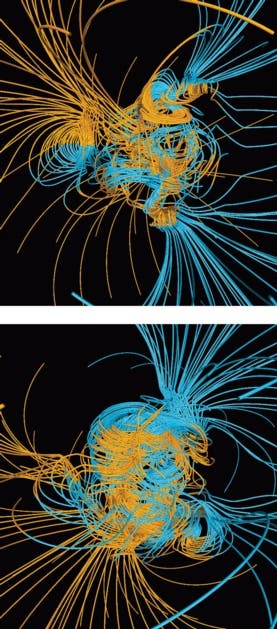Geologists have known for quite a while that the Earth’s magnetic field has flipped many times throughout the planet’s history. Its dipole magnetic field, like that of a bar magnet maintains the same intensity, but for unknown reason(s), it sometimes becomes weaker and changes polarity. Now, a new study has showed that this phenomenon could happen much faster than previously believed – even in a few decades.
Flipping the Poles

COURTESY OF GARY A. GLATZMAIER University of California, Santa Cruz, AND PAUL H. ROBERTS University of California, Los Angeles
Earth’s magnetic field, also known as the geomagnetic field, is the magnetic field that extends from the Earth’s interior to where it meets the solar wind, a stream of charged particles emanating from the Sun. Because the magnetic field is generated by a geodynamo (the motion of molten iron alloys in its outer core), the field intensity changes in time. As you probably know, the geographic North Pole and the magnetic North Pole don’t coincide – they vary significantly, as the magnetic poles wander on the surface of the planet. These reversals of the geomagnetic poles leave a record in rocks which can be used by geophysicists to trace the magnetic reversals of the past. We know for quite some time that magnetic pole reversal is a common phenomenon, even though we don’t know exactly why it happens.
In simulations of planetary dynamos, reversals often emerge spontaneously from the underlying dynamics; also, global field reversals at irregular intervals have also been observed in the laboratory liquid metal experiment VKS2. However, some scientists believe that geomagnetic reversals are not spontaneous processes but rather are triggered by external events that directly disrupt the flow in the Earth’s core. Should this be the case, the cause is likely an inside, tectonic phenomenon.
Faster than Estimated

A new study conducted by scientists from Italy, France, Columbia University and the University of California, Berkeley, demonstrated that the last magnetic reversal 786,000 years ago actually happened very quickly, in less than 100 years. If this is true, then there is no reason why this couldn’t happen again.
“It’s amazing how rapidly we see that reversal,” said UC Berkeley graduate student Courtney Sprain. “The paleomagnetic data are very well done. This is one of the best records we have so far of what happens during a reversal and how quickly these reversals can happen.”
Many geophysicists believe that we are due for another magnetic pole reversal this millennium because the Earth’s magnetic field is decreasing 10 times faster than normal, and this new evidence shows just how quickly that could happen. There are no catastrophic events associated with this reversal, though it will likely affect electrical grids and perhaps even cancer rates.
The main problem would be the electrical grid – a quick reversal, on the time scale of a few decades would wreak havoc on our modern economy, so it’s crucial that we understand more about this phenomenon. Furthermore, just because we haven’t discovered any biological catastrophes doesn’t mean that there won’t be any at all. The danger to life would be even greater if flips were preceded by long periods of unstable magnetic behavior.
“We should be thinking more about what the biologic effects would be,” Renne said.
How they Figured it Out

The new findings are based on research conducted on the magnetic field alignment in layers of ancient lake sediments now exposed in the Sulmona basin of the Apennine Mountains east of Rome, Italy. The lake sediments have interlying ash deposits from the Roman volcanic province. Italian researchers led by Leonardo Sagnotti of Rome’s National Institute of Geophysics and Volcanology measured the magnetic field directions embedded in the sediments and then used argon-argon dating to find out the age of the rocks. Basically, because lake sediments were deposited steadily and because the volcanic sediments show the magnetic orientation of the poles, the team was able to show how the latest magnetic reversal took place approximately 786,000 years ago.
“What’s incredible is that you go from reverse polarity to a field that is normal with essentially nothing in between, which means it had to have happened very quickly, probably in less than 100 years,” said Renne. “We don’t know whether the next reversal will occur as suddenly as this one did, but we also don’t know that it won’t.”
They also note that the magnetic pole reversal was preceded by a period of instability which lasted about 6,000 years. The team is now working to paint an even more accurate picture of how the pole reversal took place.


